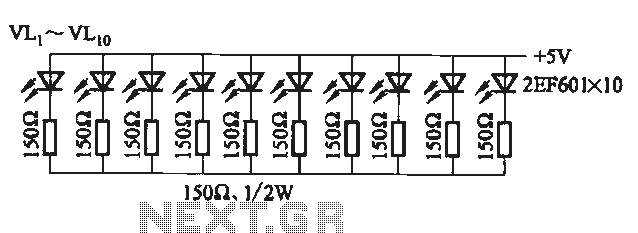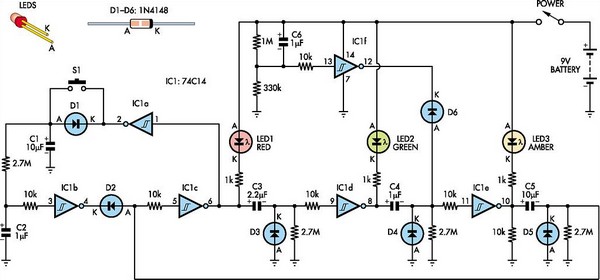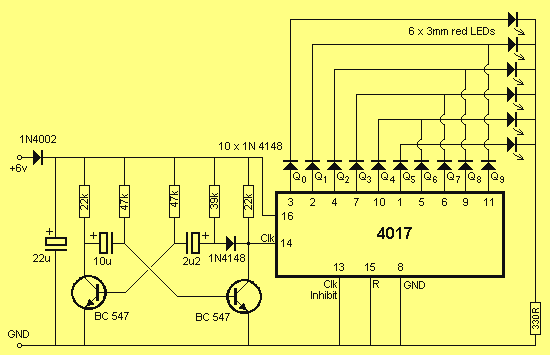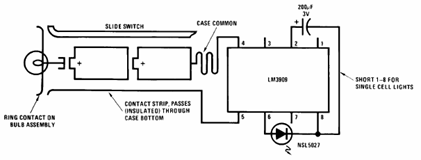
Run Lights
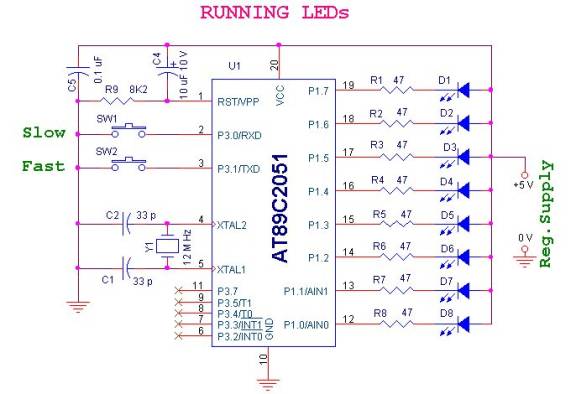
The circuit is simple and straightforward. Two inputs are included to demonstrate input control and software debouncing. An ATMEL microcontroller AT89C2051 is utilized to control the sequential glowing of LEDs, creating a running light effect. A 12 MHz crystal is employed for the basic timing of the controller. The microcontroller's VCC pin is grounded through a 0.1 µF capacitor, which should be placed as close as possible to the microcontroller's VCC pin to protect against radio frequency interference (RFI).
The circuit design focuses on a sequential LED driver system using the ATMEL AT89C2051 microcontroller. This microcontroller operates at a frequency of 12 MHz, determined by the attached crystal oscillator, which ensures accurate timing for LED activation. The circuit features two input lines that serve dual purposes: they allow for user interaction and facilitate software debouncing, which is crucial for preventing erroneous multiple triggers from mechanical switches.
The microcontroller's VCC pin is connected to a 5V power supply, with a 0.1 µF capacitor connected to ground. This capacitor acts as a bypass capacitor, filtering out high-frequency noise and stabilizing the power supply voltage, thereby enhancing the performance of the microcontroller and reducing the risk of interference from external radio frequency sources.
The LED control logic is implemented in the microcontroller's firmware, which sequentially activates the LEDs connected to its output pins. Each LED is turned on and off in a programmed sequence, creating a visually appealing running light effect. The circuit can be expanded or modified by adding more LEDs or adjusting the timing parameters in the firmware to create different light patterns.
Additional features may include the integration of resistors in series with the LEDs to limit current and prevent damage, as well as the potential for additional input mechanisms, such as push buttons or sensors, to alter the LED sequence dynamically. Overall, this circuit exemplifies a practical application of microcontroller technology in creating visually engaging light displays.Circuit is very simple and straightforward. Two inputs are added just to give an idea of input control and software denouncing. An ATMEL Micro-controller AT89C2051 is used to control the LED glowing one by one to give the effect of running light. A 12 M Hz crystal is used for basic timings of controller. Micro-controller VCC pin has grounded by on e 0. 1 uF capacitor, it should always to be grounded very near to micro-controller VCC pin to protect by and RFI (Radio Frequency interference). 🔗 External reference
The circuit design focuses on a sequential LED driver system using the ATMEL AT89C2051 microcontroller. This microcontroller operates at a frequency of 12 MHz, determined by the attached crystal oscillator, which ensures accurate timing for LED activation. The circuit features two input lines that serve dual purposes: they allow for user interaction and facilitate software debouncing, which is crucial for preventing erroneous multiple triggers from mechanical switches.
The microcontroller's VCC pin is connected to a 5V power supply, with a 0.1 µF capacitor connected to ground. This capacitor acts as a bypass capacitor, filtering out high-frequency noise and stabilizing the power supply voltage, thereby enhancing the performance of the microcontroller and reducing the risk of interference from external radio frequency sources.
The LED control logic is implemented in the microcontroller's firmware, which sequentially activates the LEDs connected to its output pins. Each LED is turned on and off in a programmed sequence, creating a visually appealing running light effect. The circuit can be expanded or modified by adding more LEDs or adjusting the timing parameters in the firmware to create different light patterns.
Additional features may include the integration of resistors in series with the LEDs to limit current and prevent damage, as well as the potential for additional input mechanisms, such as push buttons or sensors, to alter the LED sequence dynamically. Overall, this circuit exemplifies a practical application of microcontroller technology in creating visually engaging light displays.Circuit is very simple and straightforward. Two inputs are added just to give an idea of input control and software denouncing. An ATMEL Micro-controller AT89C2051 is used to control the LED glowing one by one to give the effect of running light. A 12 M Hz crystal is used for basic timings of controller. Micro-controller VCC pin has grounded by on e 0. 1 uF capacitor, it should always to be grounded very near to micro-controller VCC pin to protect by and RFI (Radio Frequency interference). 🔗 External reference


